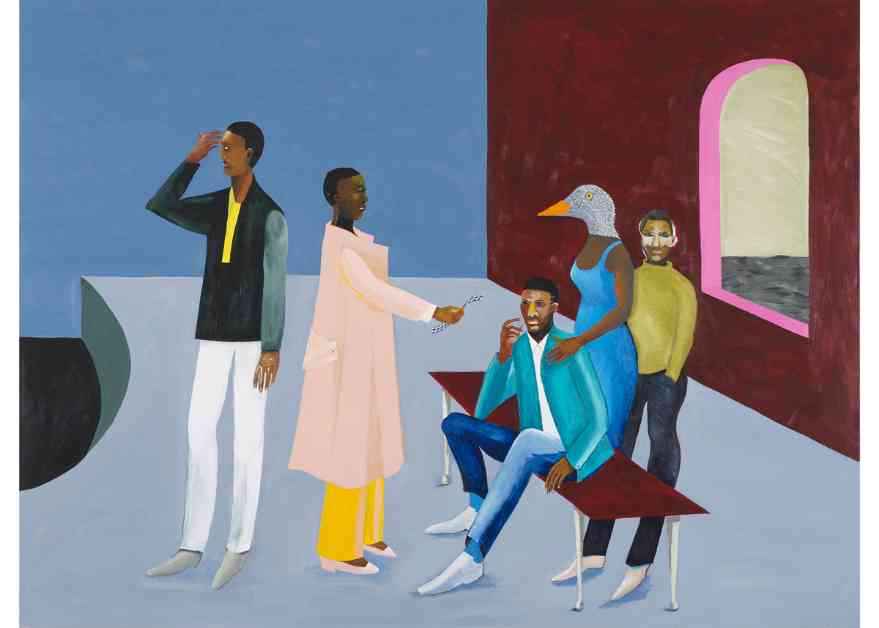Exploring Black Figuration at Philadelphia Museum of Art
A diverse collection of interpretations and representations of the Black figure is currently on display at the Philadelphia Museum of Art until February 9. Curated by British writer and curator Ekow Eshun, “The Time Is Always Now: Artists Reframe the Black Figure” showcases over 60 artworks from 28 Black and African diasporic contemporary artists, including Kerry James Marshall, Amy Sherald, Noah Davis, Wangechi Mutu, Toyin Ojih Odutola, Nathaniel Mary Quinn, Claudette Johnson, Titus Kaphar, Denzil Forrester, and Danielle Mckinney, each bringing a unique style and perspective to the exhibition.
A captivating bronze sculpture of a Black woman’s head by Mutu, positioned near Marshall’s iconic portrait of a Black woman artist, sets the tone for this thought-provoking exhibition. The pieces on display range from dreamy and almost nightmarish scenes by Davis, referencing historical events like the Tulsa Race Massacre, to poignant portraits like Kaphar’s “Seeing Through Time 2.” The artworks provoke deep reflection, with Mckinney’s serene depiction of a Black woman reading juxtaposed with Forrester’s vibrant club scene, adding layers of complexity to the narrative.
To gain further insight into the exhibition, ARTnews had the opportunity to speak with Ekow Eshun via Zoom. His vision for the exhibition was born out of a desire to celebrate the flourishing of Black artists working in figuration over the past decade. Eshun saw a shift in perspective within the art world, where Black artists were not only depicting the Black figure but also inviting a reevaluation of Western art history. The artists in the exhibition challenge traditional notions of representation, focusing on interiority and subjectivity rather than naturalism.
The conversation between the artists represented in the exhibition revolves around nuance and depth, moving away from simple depictions of the Black figure to explore the complexity of Black experiences. Artists like Marshall and Sherald deliberately push boundaries by using exaggerated skin tones or unconventional color choices to challenge viewers’ perceptions. Davis delves into the psychological aspects of Black identity, creating paintings that blur the lines between reality and the surreal.
Eshun organized the exhibition into three themes: “Double Consciousness,” “Past and Presence,” and “Our Aliveness.” These themes serve as loose frameworks to guide viewers through the diverse works on display, offering different perspectives and readings of the art. The goal was not to restrict the artists to these themes but to provide a space for exploration and discovery.
The presentation of the exhibition at the Philadelphia Museum of Art offers a new context for the artworks, allowing for a more expansive and immersive experience. The larger space accommodates additional artists, including local talents like Jonathan Lyndon Chase and Roberto Lugo, enhancing the diversity of voices represented. The timing of the exhibition, coinciding with a pivotal moment in American history, adds an extra layer of significance and poignancy to the artworks, highlighting the role of art in reflecting and responding to societal challenges.
Eshun emphasizes that the exhibition is not simply about representation but about inviting inquiry and exploration. The title, “The Time Is Always Now,” reflects the ongoing conversation within the art world about Black figuration and identity. It encourages viewers to continue looking, feeling, and reaching for a deeper understanding of what it means to navigate the world as a Black individual. The urgency of the title lies in the ever-evolving nature of Black experiences and the need for continuous dialogue and reflection.
In conclusion, “The Time Is Always Now: Artists Reframe the Black Figure” offers a compelling and immersive journey into the complexities of Black representation and identity. Through a diverse range of artworks and perspectives, the exhibition challenges traditional narratives and invites viewers to engage in a deeper exploration of Black experiences. As Eshun aptly puts it, the now is always a moment in motion, a space for ongoing inquiry and reflection into the multifaceted nature of Black existence.












